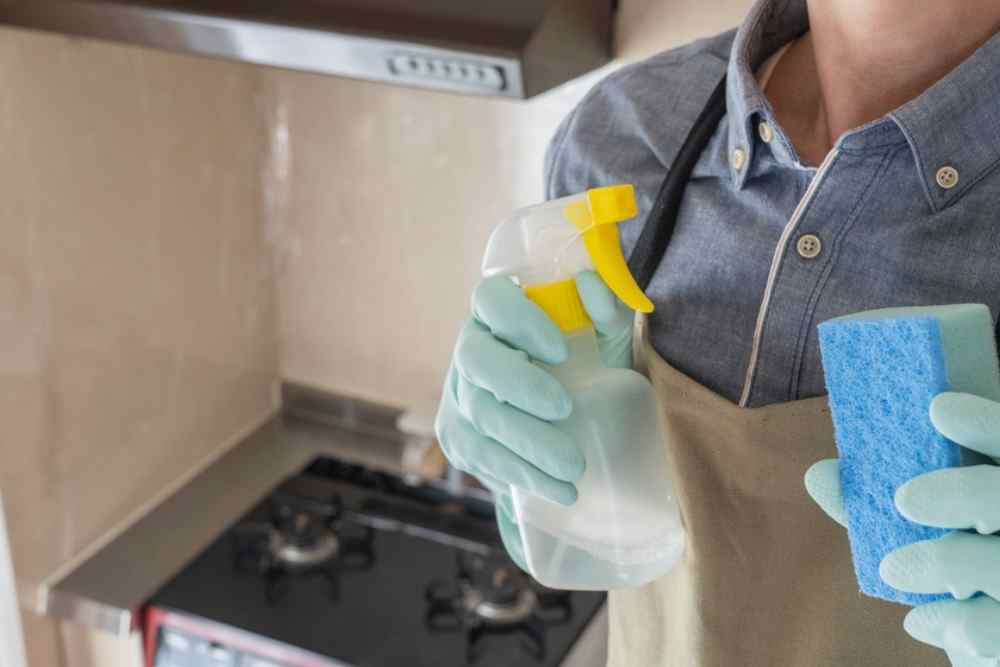Do-It-Yourself Kitchen Exhaust Cleaning

Keeping your kitchen clean and free from grease and odors is essential for maintaining a healthy and pleasant cooking environment. One crucial aspect of kitchen cleanliness is the regular cleaning of your kitchen exhaust system. A clean kitchen exhaust not only improves air quality but also reduces the risk of fire hazards. While professional cleaning services are available, many homeowners prefer to take matters into their own hands and perform DIY kitchen exhaust cleaning. In this article, we will explore the benefits of DIY kitchen exhaust cleaning, provide step-by-step instructions, and offer valuable insights to help you maintain a clean and safe kitchen environment.
Ontario-wide Kitchen Exhaust and Hood Cleaning – Best prices and service guaranteed.
The Importance of Kitchen Exhaust Cleaning
Before diving into the details of DIY kitchen exhaust cleaning, it is crucial to understand why regular cleaning is necessary. The kitchen exhaust system, including the range hood and ductwork, plays a vital role in removing smoke, grease, and odors from your kitchen. Over time, these substances accumulate and form a greasy residue, which can lead to several issues:
Ontario-wide Kitchen Exhaust and Hood Cleaning – Best prices and service guaranteed.
- Reduced air quality: A dirty kitchen exhaust system can release harmful pollutants into the air, affecting the health of you and your family. These pollutants can cause respiratory problems, allergies, and other health issues.
- Increased fire risk: Grease buildup in the exhaust system is highly flammable. If a fire starts in your kitchen, the grease can ignite and spread rapidly through the ductwork, causing a dangerous situation.
- Inefficient ventilation: A clogged exhaust system hampers the proper ventilation of your kitchen. This can result in excessive heat, steam, and odors lingering in the cooking area, making it uncomfortable to work in.
- Unpleasant odors: A dirty kitchen exhaust system can emit foul odors, which can spread throughout your home. These odors can be particularly bothersome when cooking strong-smelling foods.
Given these potential issues, it is clear that regular kitchen exhaust cleaning is essential for maintaining a healthy and safe kitchen environment.
Ontario-wide Kitchen Exhaust and Hood Cleaning – Best prices and service guaranteed.
The Benefits of DIY Kitchen Exhaust Cleaning
While hiring professional cleaning services is an option, many homeowners choose to clean their kitchen exhaust systems themselves. Here are some of the benefits of DIY kitchen exhaust cleaning:
- Cost savings: Professional cleaning services can be expensive, especially if you require frequent cleanings. By performing the cleaning yourself, you can save a significant amount of money in the long run.
- Convenience: DIY cleaning allows you to clean your kitchen exhaust system at your own convenience. You can schedule the cleaning based on your availability and avoid the hassle of coordinating with external service providers.
- Control over the process: When you clean your kitchen exhaust system yourself, you have complete control over the cleaning process. You can ensure that every nook and cranny is thoroughly cleaned, providing peace of mind.
- Regular maintenance: DIY cleaning encourages regular maintenance of your kitchen exhaust system. By incorporating it into your routine, you can prevent excessive grease buildup and maintain a cleaner and safer kitchen environment.
Ontario-wide Kitchen Exhaust and Hood Cleaning – Best prices and service guaranteed.
Now that we understand the importance of kitchen exhaust cleaning and the benefits of DIY cleaning, let’s dive into the step-by-step process of cleaning your kitchen exhaust system.
Step-by-Step Guide to DIY Kitchen Exhaust Cleaning
Cleaning your kitchen exhaust system involves several steps, each of which is crucial for achieving a thorough and effective cleaning. Follow these steps to ensure a clean and safe kitchen environment:
Step 1: Gather the Necessary Supplies
Before you begin the cleaning process, gather all the necessary supplies. Here’s a list of items you will need:
- Protective gloves
- Eye protection
- Drop cloths or plastic sheets
- Bucket
- Warm water
- Degreasing cleaner or dish soap
- Scrub brush or sponge
- Microfiber cloth or paper towels
- Ventilation mask
Ontario-wide Kitchen Exhaust and Hood Cleaning – Best prices and service guaranteed.
Step 2: Turn Off the Power
Before you start cleaning, ensure that the power to your kitchen exhaust system is turned off. This will prevent any accidents or injuries during the cleaning process.
Step 3: Remove and Clean the Filters
The filters in your range hood are designed to trap grease and other particles. Start by removing the filters and soaking them in warm water mixed with a degreasing cleaner or dish soap. Allow them to soak for a few minutes to loosen the grease.
After soaking, scrub the filters gently with a brush or sponge to remove any remaining grease. Rinse them thoroughly with warm water and let them air dry before reinstalling them.
Ontario-wide Kitchen Exhaust and Hood Cleaning – Best prices and service guaranteed.
Step 4: Clean the Range Hood
Using a degreasing cleaner or dish soap, wipe down the exterior and interior surfaces of the range hood. Pay special attention to areas with visible grease buildup. Use a scrub brush or sponge to remove stubborn grease stains.
Once you have cleaned the surfaces, rinse them with warm water and wipe them dry with a microfiber cloth or paper towels.
Step 5: Clean the Ductwork
Cleaning the ductwork requires a bit more effort and may be best left to professionals. However, if you choose to clean the ductwork yourself, follow these steps:
- Disconnect the ductwork from the range hood and remove any accessible sections.
- Using a brush or vacuum cleaner with a long attachment, remove loose debris and dust from the ductwork.
- Mix warm water with a degreasing cleaner or dish soap and use a brush or sponge to clean the interior surfaces of the ductwork.
- Rinse the ductwork thoroughly with warm water and allow it to dry completely before reconnecting it.
Ontario-wide Kitchen Exhaust and Hood Cleaning – Best prices and service guaranteed.
Step 6: Clean the Vent Cover
The vent cover is the final component of your kitchen exhaust system that requires cleaning. Remove the vent cover and soak it in warm water mixed with a degreasing cleaner or dish soap. Scrub it gently to remove any grease or dirt.
Rinse the vent cover with warm water and let it air dry before reinstalling it.
Ontario-wide Kitchen Exhaust and Hood Cleaning – Best prices and service guaranteed.
Regular cleaning of your kitchen exhaust system is crucial for maintaining a clean and safe kitchen environment. DIY kitchen exhaust cleaning offers several benefits, including cost savings, convenience, and control over the cleaning process. By following a step-by-step guide, you can effectively clean your kitchen exhaust system and prevent issues such as reduced air quality, fire hazards, inefficient ventilation, and unpleasant odors. Remember to gather the necessary supplies, turn off the power, and clean the filters, range hood, ductwork, and vent cover. By incorporating DIY kitchen exhaust cleaning into your routine, you can enjoy a healthier and more enjoyable cooking experience.
Learn more about “Eco-Friendly Kitchen Exhaust Cleaning Supplies” here.
Frequently Asked Questions about Do-It-Yourself Kitchen Exhaust Cleaning

Is It Possible to Perform Kitchen Exhaust Cleaning Myself?
While it is technically possible to undertake a basic kitchen exhaust cleaning yourself, doing so comes with several caveats. First and foremost, it’s important to understand that a thorough cleaning of a kitchen exhaust system is a complex task that involves specialized equipment and techniques. Professional services adhere to strict codes and regulations to ensure both safety and effectiveness. A DIY approach can be useful for light, routine maintenance, but it is generally not recommended as a substitute for professional cleaning, particularly in commercial settings where regulations and fire codes are stringent.
What Tools and Supplies Do I Need for DIY Kitchen Exhaust Cleaning?
If you choose to perform light, interim maintenance on your kitchen exhaust system, you’ll need several tools and supplies. These may include a ladder, grease-cutting cleaner or degreaser, scrubbing brushes, cloths, a plastic scraper, and protective gear like gloves and goggles. It’s crucial to ensure the cleaner you use is appropriate for your exhaust system’s material to prevent any damage. Additionally, you’ll need to cover sensitive kitchen areas with plastic sheeting to protect against falling grease and grime. Please note that DIY cleaning is usually not sufficient for deep cleaning and decontamination, especially in commercial settings.
How Often Should I Perform DIY Kitchen Exhaust Cleaning?
The frequency with which you should clean your kitchen exhaust system largely depends on the type and volume of cooking that occurs in your kitchen. However, it’s crucial to note that a DIY cleaning should not replace professional service, which should be conducted according to the guidelines set by the National Fire Protection Association (NFPA). For home kitchens or small commercial kitchens, a light DIY cleaning might be performed every couple of months to complement the professional cleanings, which could occur semi-annually or annually based on usage and regulations.
What Are the Risks Associated with DIY Kitchen Exhaust Cleaning?
While DIY cleaning may seem like a cost-saving measure, it comes with several risks. Without the right equipment and training, it’s difficult to achieve a thorough cleaning, which could leave grease and other flammable residues in your system, increasing the risk of a fire. Inadequate cleaning can also lead to foul odors, reduced airflow, and even pest infestations. For commercial kitchens, failing to meet the cleaning standards set by local and national regulations could result in fines, legal repercussions, and potentially voiding your insurance coverage.
Can I Combine Professional Service with DIY Maintenance for Better Results?
Absolutely, and this approach is often recommended for the best long-term upkeep of your kitchen exhaust system. Professional services can perform the deep cleaning and decontamination that DIY efforts can’t achieve. Between these professional cleanings, periodic DIY maintenance can help maintain a cleaner, safer, and more efficient system. However, it’s essential to keep records of both professional and DIY cleanings and to be aware of the regulations and guidelines that apply to your type of kitchen to ensure you remain compliant at all times.
By understanding the limitations and potential risks of DIY kitchen exhaust cleaning, you can make a more informed decision about how best to maintain your system, balancing cost-effectiveness with safety and regulatory compliance.
- Do-It-Yourself Kitchen Exhaust Cleaning
- hood cleaning
- kitchen exhaust cleaning
- restaurant hood cleaning






